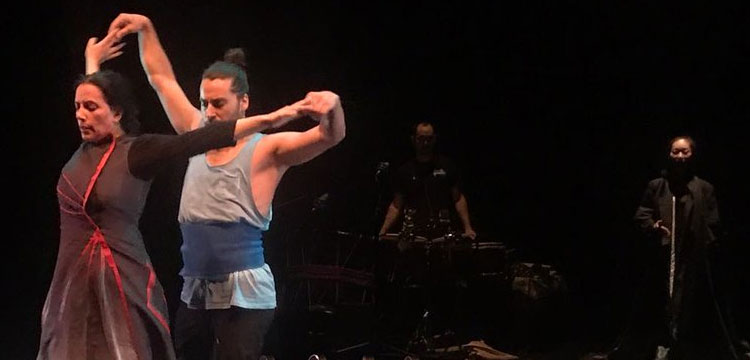The Granada dancer debuts her latest work inspired in traditional songs of the Amami Islands at the Festival Grec in Barcelona
Silvia Cruz Lapeña
The opening of Cuentos de Azúcar is anthological. Eva Yerbabuena displays all her dancer’s wisdom in a pas de deux with her other half, her doppelganger or perhaps another soul. This is interpreted by Fernando Jiménez who, behind her back, and faceless, becomes the hands and feet of the dancer who, nearly motionless, resorts to her tremendous interpretative skills to give life to that other being. Eva becomes small and large, reminding us of Alice in Wonderland, and upon fighting with her shadow, you also think of Peter Pan. It all takes place on a very dark stage, but even in the middle of that blackness, you sense a certain hope: that which is born of the imagination and of infancy. Then, unfortunately, there is no continuation.
The spirituality exuded by the work, and which the author spoke about in previous interviews, is clear, unlike the spontaneity or the promising game to which Anna Sato, the Japanese singer said she was committed, sharing the stage and bringing traditional songs from the Amami Islands. Nor does the work fulfill its promise of fantasy, at least visually, as hinted at in the promotion (videos, photos, press releases) which showed color, hair-dos and wardrobe that gave a glimpse of oriental elements. The result, nevertheless, is more gloomy than straightforward.
Superb singing
The show has several strong points. One is the musical direction of Paco Jarana, who managed to conceal the fact that there were two works in one, the flamenco on one hand, and Japanese on the other. Another is the quality of Jiménez, who had another pas de deux with the maestra and a modern solo in which some similar techniques of Rocío Molina in Bosque Ardora were employed. Precisely for this reason, her presence on stage felt like too little.
But if there were two people who bore the brunt of the work, it was the singers Miguel Ortega and Alfredo Tejada. At a venue like the Mercat de les Flors, where the audience is not given to cheers of “ole”, the spectators nearly gave a standing ovation for the alegrías facing-off of the two singers. If the former was perfect, Tejada was superb, not only because of his big voice, but also because he used it generously singing for Eva, with compás and a capacity for communication that went from the stage to the rest of the theater where people were asking “who’s that singer?”
Fusion
The shimauta, traditional songs of the Amami Islands, aren’t new in the West. In the nineteen-nineties, a pop version popularized this music in various parts of the world thanks to Sony, giving a boost to The Boom, the Japanese group that made a version for all tastes and managed to achieve an unexpected sound and very interesting patriotic identities among immigrant communities from said islands in countries such as Argentina.
As shimauta uses elements like whistling, banging and other elements that might remind one of flamenco cheering and certain things such as lamentation, joy or auguring, it also makes sense to think both cultures can be joined neatly without the glue of flamenco. This doesn’t happen in Cuentos de Azúcar, where both artistic manifestations and cultures shared the stage, but only came together at the end of the work.
The union of the two was not easy. The vocal range of shimauta is very high, depending on falsetto and with little tonal variety compared with flamenco. Even so, the artists showed that fusion is complicated but possible when in the last part of the show the musicians of both disciplines sat in a circle and dialogued. They did so musically, since thematically, and for obvious reasons the spectator could notice, they connected with the energy, but not the thread.
Little color
Yerbabuena is a great maestra. She demonstrated this in the details and in selecting the order of the pieces that make up Cuentos de Azúcar, in such a way that that circular ending, festive and having a grand time, is what left the best impression. In the most contemporary portions she took her time and it wasn’t as annoying as the monotonous repetition of certain movements, and the excessive pause in certain parts.
The staging is excellent and the idea is good, but the final result is that the shimauta and the Amami Islands are just another element, and the work lacks color, literally at times. In such a well thought-out work and so well-worked, it’s surprising to see how the wardrobe works contrary to the message: like the tones, so subdued that they take away strength from the overall impression. Only in the end does the dancer come on in blue, then pink, and something similar to happiness seems to come through. There is the tendency in flamenco, not only in this dancer, to show depth as something dark, when in actual fact thought, reflection and well-digested introspection tend to generate light and clarity.
Director, idea and choreography: Eva Yerbabuena, Music director and guitar: Paco Jarana, Special collaboration: Anna Sato, flamenco singer: Miguel Ortega, Alfredo Tejada, Percussion: Antonio Coronel, Taiko: Kaoru Watanabe, Rafael Heredia, Dance: Fernando Jiménez
Cover photo: Twitter @EvaYerbabuena
— Eva Yerbabuena (@EvaYerbabuena) 28 de julio de 2018
